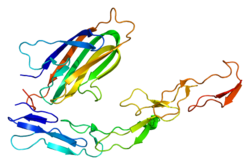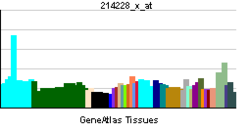- CD134
-
CD134, also known as OX40, is a member of the TNFR-superfamily of receptors which is not constitutively expressed on resting naïve T cells, unlike CD28. OX40 is a secondary costimulatory molecule, expressed after 24 to 72 hours following activation; its ligand, OX40L, is also not expressed on resting antigen presenting cells, but is following their activation. Expression of OX40 is dependent on full activation of the T cell; without CD28, expression of OX40 is delayed and of fourfold lower levels.
OX40 has no effect on the proliferative abilities of CD4+ cells for the first three days, however after this time proliferation begins to slow and cells die at a greater rate, due to an inability to maintain a high level of PKB activity and expression of Bcl-2, Bcl-XL and survivin. OX40 binds to receptors on T-cells, preventing them from dying and subsequently increasing cytokine production. OX40 has a critical role in the maintenance of an immune response beyond the first few days and onwards to a memory response due to its ability to enhance survival. OX40 also plays a crucial role in both Th1 and Th2 mediated reactions in vivo.
OX40 binds TRAF2, 3 and 5 as well as PI3K by an unknown mechanism. TRAF2 is required for survival via NF-κB and memory cell generation whereas TRAF5 seems to have a more negative or modulatory role, as knockouts have higher levels of cytokines and are more susceptible to Th2-meditated inflammation. TRAF3 may play a critical role in OX40-mediated signal transduction. CTLA-4 is down-regulated following OX40 engagement in vivo and the OX40-specific TRAF3 DN defect was partially overcome by CTLA-4 blockade in vivo. TRAF3 may be linked to OX40-mediated memory T cell expansion and survival, and point to the down-regulation of CTLA-4 as a possible control element to enhance early T cell expansion through OX40 signaling.
OX40 has been implicated in the pathologic cytokine storm associated with certain viral infections, including the H5N1 bird flu. An artificially created biologic fusion protein, OX40-immunoglobulin (OX40-Ig), prevents OX40 from reaching the T-cell receptors, thus reducing the T-cell response. Experiments in mice have demonstrated that OX40-Ig can reduce the symptoms associated with the cytokine storm (an immune overreaction) while allowing the immune system to fight off the virus successfully.
Interactions
CD134 has been shown to interact with TRAF5[1] and TRAF2.[2]
References
- ^ Kawamata, S; Hori T, Imura A, Takaori-Kondo A, Uchiyama T (Mar. 1998). "Activation of OX40 signal transduction pathways leads to tumor necrosis factor receptor-associated factor (TRAF) 2- and TRAF5-mediated NF-kappaB activation". J. Biol. Chem. (UNITED STATES) 273 (10): 5808–14. doi:10.1074/jbc.273.10.5808. ISSN 0021-9258. PMID 9488716.
- ^ Arch, R H; Thompson C B (Jan. 1998). "4-1BB and Ox40 are members of a tumor necrosis factor (TNF)-nerve growth factor receptor subfamily that bind TNF receptor-associated factors and activate nuclear factor kappaB". Mol. Cell. Biol. (UNITED STATES) 18 (1): 558–65. ISSN 0270-7306. PMC 121523. PMID 9418902. http://www.pubmedcentral.nih.gov/articlerender.fcgi?tool=pmcentrez&artid=121523.
- (1) So T, Salek-Ardakani S, Nakano H, Ware CF, Croft M (2004). "TNF receptor-associated factor 5 limits the induction of Th2 immune responses". J. Immunol. 172 (7): 4292–7. PMID 15034043.
- Song J, Salek-Ardakani S, Rogers PR, Cheng M, Van Parijs L, Croft M (2004). "The costimulation-regulated duration of PKB activation controls T cell longevity". Nat. Immunol. 5 (2): 150–8. doi:10.1038/ni1030. PMID 14730361.
- Song J, So T, Cheng M, Tang X, Croft M (2005). "Sustained survivin expression from OX40 costimulatory signals drives T cell clonal expansion". Immunity 22 (5): 621–31. doi:10.1016/j.immuni.2005.03.012. PMID 15894279.
- Croft M (2003). "Co-stimulatory members of the TNFR family: keys to effective T-cell immunity?". Nat. Rev. Immunol. 3 (8): 609–20. doi:10.1038/nri1148. PMID 12974476.
- Rogers PR, Song J, Gramaglia I, Killeen N, Croft M (2001). "OX40 promotes Bcl-xL and Bcl-2 expression and is essential for long-term survival of CD4 T cells". Immunity 15 (3): 445–55. doi:10.1016/S1074-7613(01)00191-1. PMID 11567634.
For Further reading see Watts TH (2005). "TNF/TNFR family members in costimulation of T cell responses". Annu. Rev. Immunol. 23: 23–68. doi:10.1146/annurev.immunol.23.021704.115839. PMID 15771565.
1-50 CD1 (a-c, 1A, 1D, 1E) · CD2 · CD3 (γ, δ, ε) · CD4 · CD5 · CD6 · CD7 · CD8 (a) · CD9 · CD10 · CD11 (a, b, c) · CD13 · CD14 · CD15 · CD16 (A, B) · CD18 · CD19 · CD20 · CD21 · CD22 · CD23 · CD24 · CD25 · CD26 · CD27 · CD28 · CD29 · CD30 · CD31 · CD32 (A, B) · CD33 · CD34 · CD35 · CD36 · CD37 · CD38 · CD39 · CD40 · CD41 · CD42 (a, b, c, d) · CD43 · CD44 · CD45 · CD46 · CD47 · CD48 · CD49 (a, b, c, d, e, f) · CD5051-100 CD51 · CD52 · CD53 · CD54 · CD55 · CD56 · CD57 · CD58 · CD59 · CD61 · CD62 (E, L, P) · CD63 · CD64 (A, B, C) · CD66 (a, b, c, d, e, f) · CD68 · CD69 · CD70 · CD71 · CD72 · CD73 · CD74 · CD78 · CD79 (a, b) · CD80 · CD81 · CD82 · CD83 · CD84 · CD85 (a, d, e, h, j, k) · CD86 · CD87 · CD88 · CD89 · CD90 · CD91- CD92 · CD93 · CD94 · CD95 · CD96 · CD97 · CD98 · CD99 · CD100101-150 CD101 · CD102 · CD103 · CD104 · CD105 · CD106 · CD107 (a, b) · CD108 · CD109 · CD110 · CD111 · CD112 · CD113 · CD114 · CD115 · CD116 · CD117 · CD118 · CD119 · CD120 (a, b) · CD121 (a, b) · CD122 · CD123 · CD124 · CD125 · CD126 · CD127 · CD129 · CD130 · CD131 · CD132 · CD133 · CD134 · CD135 · CD136 · CD137 · CD138 · CD140b · CD141 · CD142 · CD143 · CD144 · CD146 · CD147 · CD148 · CD150151-200 CD151 · CD152 · CD153 · CD154 · CD155 · CD156 (a, b, c) · CD157 · CD158 (a, d, e, i, k) · CD159 (a, c) · CD160 · CD161 · CD162 · CD163 · CD164 · CD166 · CD167 (a, b) · CD168 · CD169 · CD170 · CD171 · CD172 (a, b, g) · CD174 · CD177 · CD178 · CD179 (a, b) · CD181 · CD182 · CD183 · CD184 · CD185 · CD186 · CD191 · CD192 · CD193 · CD194 · CD195 · CD196 · CD197 · CDw198 · CDw199 · CD200201-250 CD201 · CD202b · CD204 · CD205 · CD206 · CD207 · CD208 · CD209 · CDw210 (a, b) · CD212 · CD213a (1, 2) · CD217 · CD218 (a, b) · CD220 · CD221 · CD222 · CD223 · CD224 · CD225 · CD226 · CD227 · CD228 · CD229 · CD230 · CD233 · CD234 · CD235 (a, b) · CD236 · CD238 · CD239 · CD240CE · CD240D · CD241 · CD243 · CD244 · CD246 · CD247- CD248 · CD249251-300 CD252 · CD253 · CD254 · CD256 · CD257 · CD258 · CD261 · CD262 · CD264 · CD265 · CD266 · CD267 · CD268 · CD269 · CD271 · CD272 · CD273 · CD274 · CD275 · CD276 · CD278 · CD279 · CD280 · CD281 · CD282 · CD283 · CD284 · CD286 · CD288 · CD289 · CD290 · CD292 · CDw293 · CD294 · CD295 · CD297 · CD298 · CD299301-350 Cytokine receptors Chemokine receptor
(GPCRs)OtherTNF receptor 1-1011-2021-25JAK-STAT OtherIg superfamily IL-17 family S/T Categories:- Human proteins
- T cells
- Clusters of differentiation
Wikimedia Foundation. 2010.


